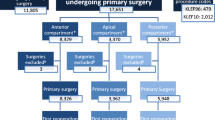Abstract
We conducted this study to estimate the rate of, and identify risk factors for, recurrent pelvic organ prolapse (POP) following primary surgical repair. The study consisted of a retrospective cohort study of 142 women who underwent primary surgical management of POP in 1993 and were followed up to 10 years. Prolapse severity was graded using an established classification system of clinical descriptors. Hazard ratios (HR) for recurrent POP were determined using Cox regression. 36 recurrent cases were identified (recurrence rate: 3.7 per 100 woman-years). A cystocele was the most frequent element of primary (87%) and recurrent (72%) prolapse. No predictors of the likelihood of recurrence were identified, though recurrence was somewhat more common among women with a history of two or fewer vaginal deliveries vs three or more (HR = 1.6; 95% confidence interval = 0.81–3.3). Recurrent POP following surgical management is common. Our ability to predict recurrence is limited.


Similar content being viewed by others
References
Boyles SH, Weber AM, Meyn L (2003) Procedures for pelvic organ prolapse in the United States, 1979–1997. Am J Obstet Gynecol 188:108–115
Nygaard I, Bradley C, Brandt D (2004) Pelvic organ prolapse in older women: prevalence and risk factors. Obstet Gynecol 104:489–497
Olsen AL, Smith VJ, Bergstrom JO, Colling JC, Clark AL (1997) Epidemiology of surgically managed pelvic organ prolapse and urinary incontinence. Obstet Gynecol 89:501–506
Clark AL, Gregory T, Smith VJ, Edwards R (2003) Epidemiologic evaluation of reoperation for surgically treated pelvic organ prolapse and urinary incontinence. Am J Obstet Gynecol 189:1261–1267
Handa VL, Garrett E, Hendrix S, Gold E, Robbins J (2004) Progression and remission of pelvic organ prolapse: a longitudinal study of menopausal women. Am J Obstet Gynecol 190:27–32
Hendrix SL, Clark A, Nygaard I, Aragaki A, Barnabei V, McTiernan A (2002) Pelvic organ prolapse in the Women’s Health Initiative: gravity and gravidity. Am J Obstet Gynecol 186:1160–1166
Vakili B, Zheng YT, Loesch H, Echols KT, Franco N, Chesson RR (2005) Levator contraction strength and genital hiatus as risk factors for recurrent pelvic organ prolapse. Am J Obstet Gynecol 192:1592–1598
Whiteside JL, Weber AM, Meyn LA, Walters MD (2004) Risk factors for prolapse recurrence after vaginal repair. Am J Obstet Gynecol 191:1533–1538
Conflicts of interest
None.
Author information
Authors and Affiliations
Corresponding author
Additional information
Funding: Supported by National Institute of Child Health and Human Development—National Institutes of Health grant no. K12 HD1264-07
Appendix
Appendix
Rights and permissions
About this article
Cite this article
Fialkow, M.F., Newton, K.M. & Weiss, N.S. Incidence of recurrent pelvic organ prolapse 10 years following primary surgical management: a retrospective cohort study. Int Urogynecol J 19, 1483–1487 (2008). https://doi.org/10.1007/s00192-008-0678-8
Received:
Accepted:
Published:
Issue Date:
DOI: https://doi.org/10.1007/s00192-008-0678-8




